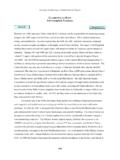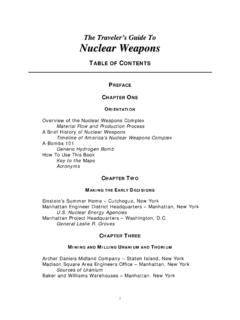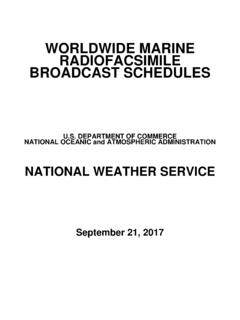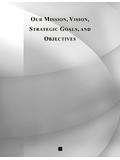Transcription of The Containment of Underground Nuclear Explosions
1 The Containment of Underground Nuclear Explosions October 1989. NTIS order #PB90-156183. Recommended Citation: Congress, Office of Technology Assessment, The Containment of Underground Nuclear Explosions , OTA-ISC-414 (Washington, DC: Government Printing Office, October 1989), Library of Congress Catalog Card Number 89-600707. For sale by the Superintendent of Documents Government Printing Office, Washington, DC 20402-9325. (order form can be found in the back of this report). Foreword Within weeks after the ending of World War II, plans for the first Nuclear test series Operation Crossroads were underway. The purpose then, as now, was to develop new weapon systems and to study the effects of Nuclear Explosions on military equipment. The development of the Nuclear testing program has been paralleled by public opposition from both an arms control and an environmental perspective. Much of the criticism is due to the symbolic nature of testing Nuclear weapons and from the radiation hazards associated with the early practice of testing in the atmosphere.
2 Recently, however, specific concerns have also been raised about the current Underground testing program; namely: . Are testing practices safe? . Could an accidental release of radioactive material escape undetected? Is the public being fully informed of all the dangers emanating from the Nuclear testing program? These concerns are fueled in part by the secrecy that surrounds the testing program and by publicized problems at Nuclear weapons production facilities. At the request of the House Committee on Interior and Insular Affairs and Senator Orrin G. Hatch, OTA undertook an assessment of the Containment and monitoring practices of the Nuclear testing program. This special report reviews the safety of the Nuclear testing program and assesses the technical procedures used to test Nuclear weapons and ensure that radioactive material produced by test Explosions remains contained Underground . An overall evaluation considers the acceptability of the remaining risk and discusses reasons for the lack of public confidence.
3 In the course of this assessment, OTA drew on the experience of many organizations and individuals. We appreciate the assistance of the Government agencies and private companies who contributed valuable information, the workshop participants who provided guidance and review, and the many additional reviewers who helped ensure the accuracy and objectivity of this report. ,.. Ill Workshop 1: Containment Monday, Sept. 26,1988. Environmental Research Center University of Nevada, Las Vegas Neville G. Cook, Chair Department of Material Science and Mineral Engineering University of California Frederick N. App Evan Jenkins Section Leader Geological Survey Containment Geophysics Joseph LaComb Los Alamos National Laboratory Chief Norman R. Burkhard Nevada Operations Office Containment Program Leader Defense Nuclear Agency Lawrence Livermore National Laboratory James K. Magruder Jim Carothers Assistant Manager for Operations and Engineering Chairman Nevada Operations Office Containment Evaluation Panel Department of Energy Lawrence Livermore National Laboratory Paul Orkild Jack Evernden Geological Survey Lawrence Livermore National Laboratory Edward W.
4 Peterson Geological Survey Containment Project Director Robert A. Fulkerson S-CUBED. Executive Director John Stewart Citizen Alert Director Jack W. House Test Operations Division Containment Program Manager Nevada Operations Office Los Alamos National Laboratory Department of Energy Billy C. Hudson Deputy Containment Program Leader Lawrence Livermore National Laboratory iv Workshop 2: Monitoring Tuesday, Sept. 27, 1988. Environmental Research Center University of Nevada, Las Vegas Melvin W. Carter, Chair Neely Professor Emeritus Georgia Institute of Technology Bernd Franke Lynn R. Anspaugh IFEU. Division Leader Environmental Sciences Division Robert A. Fulkerson Lawrence Livermore National Laboratory Executive Director Citizen Alert Bruce Church Assistant Manager for Environmental Safety and Michael A. Marelli Health Chief, Health Protection Branch Nevada Operations Office Health Physics and Environmental Division Department of Energy Nevada Operations Office Department of Energy Charles F.
5 Costa Director Darryl Randerson Nuclear Radiation Assessment Division Weather Service United States Environmental Protection Agency Nuclear Office Donald R. Elle Chief, Technical Projects Branch Health Physics and Environmental Division Nevada Operations Office Department of Energy OTA Project Staff-The Containment of Underground Nuclear Explosions Lionel S. Johns, Assistant Director, OTA. Energy, Materials, and International Security Division Peter Sharfman, International Security and commerce Program Manager*. Alan Shaw, International Security and commerce Program Manager**. Gregory E. van der Vink, Project Director Administrative Staff Jannie Horne (through November 1988). Marie C. Parker (through April 1989). Jackie Robinson Louise Staley Through February 1989. *From March 1989. vi Acknowledgments OTA gratefully acknowledges the valuable contributions made by the following: Lynn R. Anspaugh David Graham Lawrence Livermore National Laboratory Moore College of Art Frederick N.
6 App Jack W. House Los Alamos National Laboratory Los Alamos National Laboratory Nick Aquilina Billy C. Hudson Department of Energy Lawrence Livermore National Laboratory Charles Archambeau Evan Jenkins CIRES, University of Colorado, Boulder Geological Survey Stuart C. Black Gerald W. Johnson Environmental Protection Agency University of California Carter Broyles Joseph W. LaComb Sandia National Laboratory Defense Nuclear Agency Norman R. Burkhard James K. Magruder Lawrence Livermore National Laboratory Department of Energy John H. Campbell Michael A. Marelli Department of Energy Department of Energy Jim Carothers LTC Samuel D. McKinney Lawrence Livermore National Laboratory Defense Nuclear Agency Melvin W. Carter David N. McNelis International Radiation Protection Consultant University of Las Vegas, Nevada Bruce Church Paul Orkild Department of Energy Lawrence Livermore National Laboratory Neville G. Cook Edward W. Peterson University of California, Berkeley S-CUBED.
7 Charles F. Costa Dorothy F. Pope Environmental Protection Agency Defense Nuclear Agency Jeff Duncan Darryl Randerson Office of Congressman Edward J. Markey Weather Service, Nuclear Office Donald R. Elle Karen Randolph Department of Energy Department of Energy Gerald L. Epstein Rhodes John F. Kennedy School of Government, Harvard University Diebold, Inc. Jack Evernden Patrick Rowe Geological Survey REECo Anthony Fainberg Robert Shirkey Office of Technology Assessment, Congress Defense Nuclear Agency Pete Fitzsimmons John O. Stewart Department of Energy Department of Energy Janet Fogg Robert Titus Department of Energy Weather Service, Nuclear Office Bernd Franke Dean R. Townsend IFEU Fenix & Scission, Inc. Robert A. Fulkerson Chris L. West Citizen Alert Department of Energy Larry Gabriel Barbara Yoers Defense Nuclear Agency Department of Energy NOTE: OTA appreciates and is grateful for the valuable assistance and thoughtful critiques provided by the contributors.
8 The contributors do not, however, necessarily approve, disapprove, or endorse this report. OTA assumes full responsibility for the report and the accuracy of its contents. Vil Page Chapter 1. Executive Summary .. 3. Chapter 2. The Nuclear Testing Program .. 11. Chapter 3. Containing Underground Nuclear Explosions .. 31. Chapter 4. Monitoring Accidental Radiation Releases.. 59. Chapter 1. Executive Summary CONTENTS. Page INTRODUCTION .. 3. HOW SAFE IS SAFE ENOUGH? .. 3. HOW SAFE HAS IT BEEN? .. 3. SPECIFIC CONCERNS .. 5. OVERALL EVALUATION ..6. Table Table Page l-1. Releases From Underground Tests .. 4. Chapter 1. Executive Summary The chances of an accidental release of radioactive material have been made as remote as possible. Public concerns about safety are fueled by concerns about the testing program in general and exacerbated by the government's policy of not announcing all tests. INTRODUCTION doubt. But the Containment Evaluation Panel has no guidelines that attempt to quantify or During a Nuclear explosion, billions of atoms describe in probabilistic terms what constitutes release their energy within a millionth of a for example, an adequate degree of confi- second, pressures reach several million pounds dence.
9 " Obviously, there can never be 100. per square inch, and temperatures are as high as percent confidence that a test will not release one-million degrees centigrade. A variety of radioactive material. Whether adequate confi- radioactive elements are produced depending on dence translates into a chance of 1 in 100, 1 in the design of the explosive device and the 1,000, or 1 in 1,000,000, requires a decision contribution of fission and fusion to the explo- about what is an acceptable level of risk. In turn, sion. The half-lives of the elements produced decisions of acceptable level of risk can only be range from less than a second to more than a made by weighing the costs of an unintentional million years. release against the benefits of testing. Conse- Each year over a dozen Nuclear weapons are quently, those who feel that testing is important detonated Underground at the Nevada Test Site. l for our national security will accept greater risk, The tests are used to develop new Nuclear and those who oppose Nuclear testing will find weapons and to assess the effects of Nuclear even small risks unacceptable.
10 Explosions on military systems and other hard- Establishing an acceptable level of risk is ware. Each test is designed to prevent the release difficult, not only because of the value judg- of radioactive material. The objective of each ments associated with Nuclear testing, but also test is to obtain the desired experimental infor- because the risk is not seen as voluntary by those mation and yet successfully contain the explo- outside the testing program. A public that sion Underground ( , prevent radioactive ma- readily accepts the risks associated with volun- terial from reaching the atmosphere). tary activities such as skydiving or smoking . may still consider the much lower risks associ- HOW SAFE IS SAFE ENOUGH? ated with Nuclear testing unacceptable. Deciding whether the testing program is safe requires a judgment of how safe is safe enough. HOW SAFE HAS IT BEEN? The subjective nature of this judgment is illustrated through the decision-making process Some insight into the safety of the Nuclear of the Containment Evaluation Panel (CEP) testing program can be obtained by reviewing which reviews and assesses the Containment of the Containment record.








